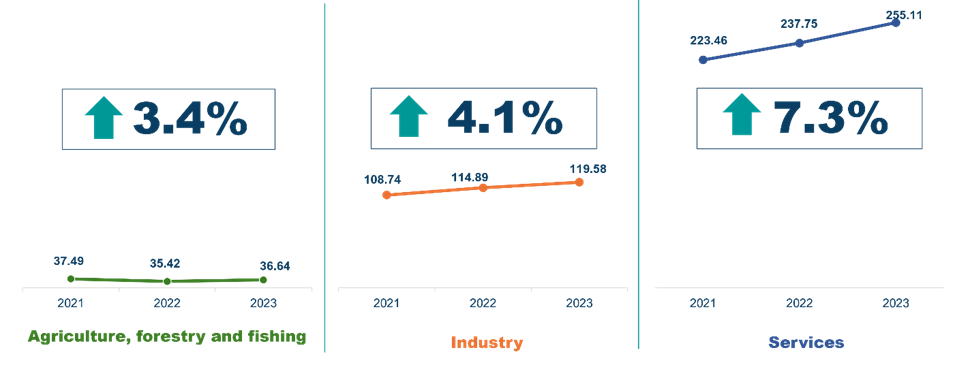The economy of the Province of Cebu grew by 6.0 percent in 2023.
The economy of Province of Cebu grew by 6.0 percent in 2023 from its 2022 level. This represents an increase in the value of Gross Domestic Product (GDP) from PhP 388.06 billion in 2022 to PhP 411.32 billion in 2023. The 2023 growth is faster than the 5.0 percent growth recorded in the previous year (Figure 1).
Figure 1. Gross Domestic Product of the Province of Cebu
In Term of Level (in Billion PhP) and Growth Rate (in Percent)
At Constant 2018 Prices, 2021 to 2023

1/ Excluding City of Cebu, City of Lapu-Lapu and City of Mandaue
Source: Philippine Statistics Authority
Economic Performance of Province of Cebu by Industry
In terms of major industries, all three recorded positive growths in 2023 for the Province of Cebu. Agriculture, forestry, and fishing (AFF) recorded a growth of 3.4 percent, Industry grew by 4.1 percent, and Services expanded by 7.3 percent (Figure 2).
Figure 2. Economic Structure of Province of Cebu
In Terms of Level (in Billion PhP), 2021 to 2023 and Growth Rate, 2023
At Constant 2018 Prices

For the contribution of each major industry to the 6.0 percent economic growth; Services shared 4.5 percentage points, Industry shared 1.2 percentage points and Agriculture, forestry, and fishing contributed 0.3 percentage points (Table 1).
In terms of performance of the 16 production industries, all contributed positively to the growth of the economy. The major contributors to the 6.0 percent growth of the province were: Professional and business services, 1.4 percentage points, Construction, 1.0 percentage point; and Wholesale and retail trade; repair of motor vehicles and motorcycles, 0.8 percentage points. Meanwhile, the top 3 fastest growing industries were: Accommodation and food service activities with 18.6 percent growth, Other services with 16.7 percent growth, and Transportation and storage with 13.3 percent growth (Table 1).
Table 1. Economic Performance of Province of Cebu by Industry
At Constant 2018 Prices, 2022 to 2023

Note: Details may not add up due to rounding
Source: Philippine Statistics Authority
Province of Cebu is mainly driven by Services among major industries
The share of the three major industries to the economy of the Province of Cebu. Services had the biggest share, accounting for 62.0 percent. Followed by Industry, with a share of 29.1 percent. Meanwhile, Agriculture, forestry, and fishing (AFF) had a share of 8.9 percent (Figure 3).
Figure 3. Economic Structure of Province of Cebu
In terms of Share of Major Industries to GDP (in Percent), 2023
At Constant 2018 Prices

Note: Details may not add up due to rounding
Source: Philippine Statistics Authority
Among the 16 industries, Manufacturing ranked 1st in terms of share to the total economy of the province with 14.9 percent. Followed by Wholesale and retail trade; repair of motor vehicles and motorcycles with 14.8 percent share, Professional and business services with 12.7 percent share, and Real estate and ownership of dwellings with 10.8 percent share. These top 4 industries contributed more than half or about 53.2 percent of the economy of the province (Figure 4).
Figure 4. Economic Structure of Province of Cebu
In Terms of Share of Industries to GDP (in Percent), 2023
At Constant 2018 Prices

Note: Details may not add up due to rounding
Source: Philippine Statistics Authority
Figure 5. Per Capita GDP of Province of Cebu
In Terms of Levels (in PhP): 2023
At Constant 2018 Prices

Technical Notes:
• Provincial Product Accounting (PPA) is a mechanism, following with the Philippine System of National Accounts (PSNA), that aims to present a comprehensive picture of the provincial and Highly Urbanized City (HUC) economies.
• Through the PPA, the Gross Domestic Product (GDP) or the economic performance of the provinces and HUCs are estimated.
• This will serve as an important tool in economic planning and policy formulation at the subregional levels to supplement the GDP at the national and regional levels or the Gross Regional Domestic Product (GRDP)
• By providing a more appropriate measure and assessment of a province’s economic performance, the PPA is viewed to strengthen the planning and decision-making of provincial policymakers and other stakeholders.
• The GDP at the provincial and HUC level is computed by Production Approach.
• That is, GDP of the province/HUC is measured from the perspective of the producers of goods and services. It covers the value of goods and services produced in the province/HUC during the reference period.
• In this approach, GDP measures the contribution of the 16 production industries, namely:
- Agriculture, forestry, and fishing;
- Mining and quarrying;
- Manufacturing;
- Electricity, steam, water, and waste management;
- Construction;
- Wholesale and retail trade; repair of motor vehicles and motorcycles;
- Transportation and storage;
- Accommodation and food service activities;
- Information and communication;
- Financial and insurance activities;
- Real estate activities;
- Professional, and business services;
- Public administration and defense; compulsory social security;
- Education;
- Human health and social work activities; and
- Other services.
Approved by:
MELCHOR B. BAUTISTA
Chief Statistical Specialist
LGS/PPGT


